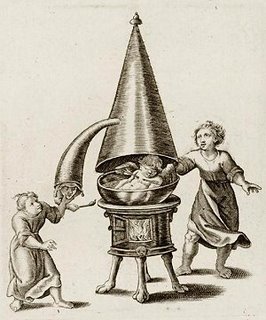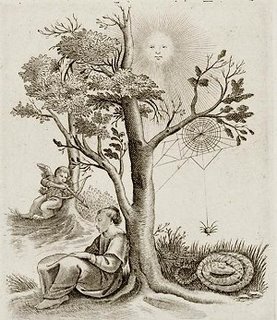 Cupid is standing on the tail of a peacock, which is hit by the arrow
Cupid is standing on the tail of a peacock, which is hit by the arrow of a man; a woman is taking aim with a bow and arrow
 A girl holding some pipes and a tobacco-pouch, stands before Cupid
A girl holding some pipes and a tobacco-pouch, stands before Cupid who is smoking a pipe, seated on a huge ball to which his foot is chained
 Blindfolded cupid with his chest pierced by an arrow is lying
Blindfolded cupid with his chest pierced by an arrow is lying in a big bowl on a stove; a head with a fool's cap and an arm
holding a bauble appears from a pipe at the side of the stove
 A cupid is taking aim at a young woman who sleeps against a tree;
A cupid is taking aim at a young woman who sleeps against a tree; behind the tree a spider is lowering himself towards a sleeping snake
This selection of love emblems comes from a 1703 Dutch book - Zinne-beelden der liefde ('something pictures of love') - by Willem den Elger.
"The Zinne-beelden der liefde is a remarkable book because it[s] appearance meant a complete change in the traditional way profane and religious emblems had influenced each other in the seventeenth century. Normally, religious emblem writers followed in the footsteps of paths laid out by profane predecessors. Otto Vaenius published Amorum emblemata before he reworked his own work into a religious variant in the Amoris divinis emblemata, and in Herman Hugo's Pia desidiria and Justus de Harduwijn's Goddelycke wenschen one can recognize many worldly sources.Despite this I would be very surprised if the above images were not derivatives from prior publications one way or another. I just liked the idea of cupid having a smoke.
Den Elger turned this practice around. His Zinne-beelden der liefde is partly indebted to a religious work, Amorum divini et humani effectus. This concept proved to be rather succesful. The fifty emblems of the Zinne-beelden der liefde were printed three times in the eighteenth century, in 1703, 1725 and 1732."
The multilingual den Elger completed a doctorate in law and published a few text and poem translations. Some of his own prose work was issued by friends after his death. An unhappy love affair is said to have caused him to die aged just 26 ... or so the story goes.
- The modestly sized emblems from Zinne-beelden der liefde are online via the Mnemosyne database.
- There is a another copy of the same images (more in the realm of photocopy) at the University of Utrecht. [a little background info] They have latin/dutch/french transcripts also.
- Get your love on.
- Previous emblem posts here.




No comments:
Post a Comment